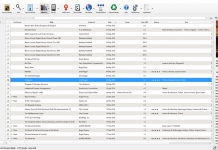 This year, Wiley & Sons celebrates 200 years of publishing. The company is responsible for the wildly popular but oft-criticized “For Dummies” books for which, like Hallmark cards, there is a book for every occasion. Wiley & Sons doesn’t stay in business because it practices old-school publishing tactics. When technology forges ahead, Wiley & Sons strives to adapt. Recently it has begun experimenting with releasing a free e-content version prior to a book’s print debut.
This year, Wiley & Sons celebrates 200 years of publishing. The company is responsible for the wildly popular but oft-criticized “For Dummies” books for which, like Hallmark cards, there is a book for every occasion. Wiley & Sons doesn’t stay in business because it practices old-school publishing tactics. When technology forges ahead, Wiley & Sons strives to adapt. Recently it has begun experimenting with releasing a free e-content version prior to a book’s print debut.
That’s not the only good news from Wiley. Joe Wikert (photo), a vice president and executive publisher in Wiley’s Professional/Trade division, acknowledges that DRM in its present form is hobbling the current e-industry. I like his candor.
Unfortunately, Wikert’s response to a reader complaint about crippling DRM is to send a signed paper copy to the blogger. I would hope that Wiley & Sons’ growth and adaptability can translate into DRM-free content; what better way to help Wiley truly come of age in this increasingly technologically attached society?


































“when we have nothing but E-books (as so many enthusiasts prophesize), what will authors sign?” (Comment left on Wickert’s post by Michael Banks .
A profound question. Maybe napkins?
I say breasts.
(Why else would you become an author?)
Branko! LMAO. But what do the women author’s sign? The manboobs? Thanks but no. What about the ol’ digital signature. It reminds of some futuristic books in which “paper” books are deemed a rare and expensive pleasure. Perhaps that is what this will come to.
I am afraid the whole idea of getting an authograph is so far removed from me that I don’t know what fans would want in lieu of an autographed book. So tell me first, why do people seek autographs? Is it a memento of coming in contact with the actual person who is their hero? Is it a form of collecting?
I guess a photo of the author with the hunter would be a substitute. This could be preserved as an annotation to the e-text.
Recently I saw a documentary about the football player Ruud van Nistelrooy. He was giving the crew a tour of Old Trafford, the stadium where he used to plie his craft. During that tour, they met several actual groups of tourists, who were of course excited to see him. But instead of asking for his autograph, they took out their camphones, wrapped an arm around him, and took a picture.
Van Nistelrooy seemed to take this all in good nature, but you could see it slightly irritated him, and at one point he involved the documentary crew in a game of avoid-the-fans. I think this has to do with control. When you write your signature, you are in control, but when a fan takes a picture, the fan is in control. This may of course also be the reason that all the fans seemed to favour a picture over an autograph.
Authors could wrest back some of that control by providing the photographer!